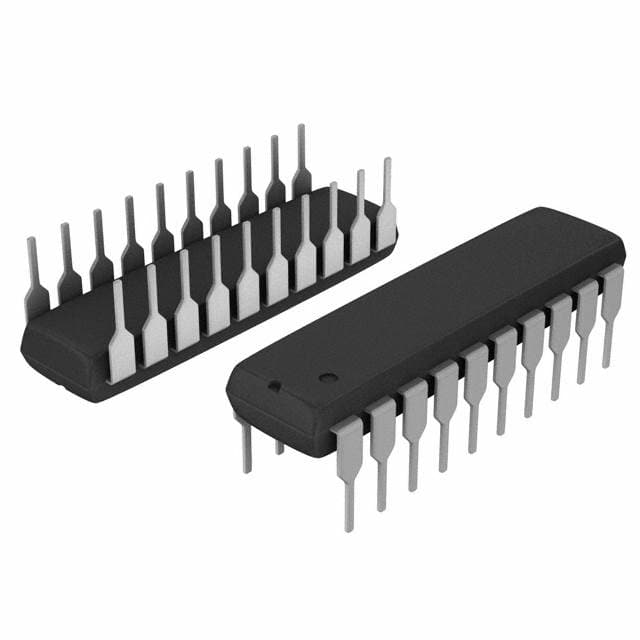Viz Specifikace pro podrobnosti o produktu.

Encyclopedia Entry: 74F623PC
Product Overview
Category
The 74F623PC belongs to the category of integrated circuits (ICs) and specifically falls under the family of digital logic devices.
Use
This product is commonly used in electronic circuits for data storage, retrieval, and manipulation. It serves as a bidirectional octal bus transceiver, facilitating the transfer of data between two separate buses.
Characteristics
- Bidirectional: The 74F623PC allows data transmission in both directions.
- Octal Bus Transceiver: It can handle eight data lines simultaneously.
- High-Speed Operation: This IC operates at high speeds, making it suitable for applications requiring quick data transfer.
- Compatibility: The 74F623PC is compatible with various logic families, including TTL (Transistor-Transistor Logic) and CMOS (Complementary Metal-Oxide-Semiconductor).
Package and Quantity
The 74F623PC is typically available in a dual in-line package (DIP) format. Each package contains one unit of the IC.
Specifications
- Supply Voltage: 4.5V to 5.5V
- Input/Output Voltage Range: 0V to Vcc
- Operating Temperature Range: -40°C to +85°C
- Maximum Propagation Delay: 10ns
- Output Drive Capability: ±24mA
Pin Configuration
The 74F623PC features a 20-pin configuration, with each pin serving a specific function. The detailed pinout is as follows:
- A0: Data Input/Output A0
- B0: Data Input/Output B0
- A1: Data Input/Output A1
- B1: Data Input/Output B1
- A2: Data Input/Output A2
- B2: Data Input/Output B2
- A3: Data Input/Output A3
- B3: Data Input/Output B3
- GND: Ground
- OE: Output Enable
- DIR: Direction Control
- Vcc: Supply Voltage
- B4: Data Input/Output B4
- A4: Data Input/Output A4
- B5: Data Input/Output B5
- A5: Data Input/Output A5
- B6: Data Input/Output B6
- A6: Data Input/Output A6
- B7: Data Input/Output B7
- A7: Data Input/Output A7
Functional Features
The 74F623PC offers the following functional features:
- Bidirectional Data Transfer: It allows data to be transmitted in both directions, enabling efficient communication between two buses.
- Output Enable (OE) Control: The OE pin enables or disables the output buffers, providing control over data transmission.
- Direction Control (DIR): The DIR pin determines the direction of data flow, allowing flexibility in system design.
Advantages and Disadvantages
Advantages
- High-Speed Operation: The 74F623PC operates at fast speeds, making it suitable for time-critical applications.
- Compatibility: It is compatible with various logic families, ensuring versatility in circuit design.
- Bidirectional Capability: The bidirectional feature simplifies data transfer between buses.
Disadvantages
- Power Consumption: The 74F623PC may consume relatively higher power compared to some low-power alternatives.
- Limited Output Drive Capability: The output drive capability of ±24mA may not be sufficient for certain high-current applications.
Working Principles
The 74F623PC functions as a bidirectional octal bus transceiver by utilizing internal circuitry to control the direction of data flow. The DIR pin determines whether data is transmitted from bus A to bus B or vice versa. The OE pin enables or disables the output buffers, allowing control over data transmission.
Application Field Plans
The 74F623PC finds applications in various fields, including:
- Data Communication Systems: It facilitates data transfer between different communication buses.
- Microprocessor Interfacing: The IC enables efficient communication between microprocessors and peripheral devices.
- Memory Systems: It can be used for interfacing with memory modules, enabling data storage and retrieval.
Alternative Models
For those seeking alternatives to the 74F623PC, the following models provide similar functionality:
- SN74ALS623A
- CD74HCT623E
- MC74HC623AN
- 74ACT623SC
These alternative models offer comparable bidirectional bus transceiver capabilities and are compatible with various logic families.
In conclusion, the 74F623PC is a versatile integrated circuit that serves as a bidirectional octal bus transceiver. Its high-speed operation, compatibility, and bidirectional capability make
Seznam 10 běžných otázek a odpovědí souvisejících s aplikací 74F623PC v technických řešeních
Sure! Here are 10 common questions and answers related to the application of 74F623PC in technical solutions:
Q: What is the 74F623PC? A: The 74F623PC is a 16-bit bus transceiver with tri-state outputs, commonly used in digital systems.
Q: What is the purpose of a bus transceiver? A: A bus transceiver allows bidirectional data transfer between two buses, enabling communication between different parts of a system.
Q: What voltage levels does the 74F623PC support? A: The 74F623PC supports TTL (Transistor-Transistor Logic) voltage levels, typically operating at 5V.
Q: How many input/output pins does the 74F623PC have? A: The 74F623PC has 8 input pins and 8 output pins, making it suitable for 8-bit data transmission.
Q: Can the 74F623PC handle high-speed data transfer? A: Yes, the 74F623PC is designed to operate at high speeds, making it suitable for applications requiring fast data transfer rates.
Q: Does the 74F623PC have built-in protection against bus contention? A: Yes, the 74F623PC includes built-in bus hold circuitry to prevent bus contention issues during simultaneous data transfers.
Q: Can I use multiple 74F623PC chips together in a system? A: Yes, you can connect multiple 74F623PC chips together to expand the number of input/output lines or create larger bus systems.
Q: Are there any special considerations when connecting the 74F623PC to other components? A: It is important to ensure that the voltage levels and timing requirements of the connected components are compatible with the 74F623PC.
Q: Can the 74F623PC be used in both synchronous and asynchronous systems? A: Yes, the 74F623PC can be used in both synchronous and asynchronous systems, depending on the specific application requirements.
Q: Are there any known limitations or common issues with the 74F623PC? A: While the 74F623PC is a reliable component, it is important to consider factors such as power supply noise, signal integrity, and proper grounding to avoid potential issues in the system.
Please note that these answers are general and may vary depending on the specific application and context. It is always recommended to refer to the datasheet and consult with technical experts for accurate information.

